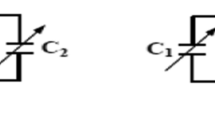Abstract
A CMOS low-voltage, wide-swing continuous-time current amplifier is presented. Exhibiting an open-loop architecture, the circuit is composed of transresistance and transconductance stages built upon triode-operating transistors. In addition to an extended dynamic range, the current gain can be programmed within good accuracy by a rapport involving only transistor geometries and tuning biases. Low temperature-drift on gain setting is then expected.
In accordance with a 0.35 μm n-well CMOS fabrication process and a single 1.1 V-supply, a balanced current-amplifier is designed for a programmable gain-range of 6–34 dB and optimized with respect to dynamic range. Simulated results from PSPICE and Bsim3v3 models indicate, for a 100 μA pp -output current, a THD of 0.96 and 1.87% at 1 KHz and 100 KHz, respectively. Input noise is 120 pA√Hz @10 Hz, with S/N = 63.2 dB @1%-THD. At maximum gain, total quiescent consumption is 334 μW. Measurements from a prototyped amplifier reveal a gain-interval of 4.8–33.1 dB and a maximum current swing of 120 μA pp . The current-amplifier bandwidth is above 1 MHz.
Similar content being viewed by others
References
T. Kaulberg, “A CMOS current-mode operational amplifier.” IEEE J. Solid-State Circuits, vol. 28, no. 7, pp. 849–852, 1993.
G. Palmisano, G. Palumbo, and S. Pennisi, CMOS Current Amplifiers. Kluwer Academic Publishers, 1999.
K. Koli and K. Halonen, CMOS Current Amplifiers: Speed Versus Nonlinearity. Kluwer Academic Publishers, 2002.
Z. Wang and W. Guggenbühl, “Adjustable bidirectional CMOS current gain cell.” Eletron. Lett., vol. 25, no. 10, pp. 673–675, 1989.
E. Klumperink and H. Janssen, “Complementary CMOS current gain cell.” Eletron. Lett., vol. 27, no. 1, pp. 38–40, 1991.
Z. Wang, “Wideband class AB (push-pull) current amplifier in CMOS technology.” Eletron. Lett., vol. 26, no. 8, pp. 543–545, 1990.
G. Palmisano, G. Palumbo, and S. Pennisi, “High-drive CMOS current amplifier.” IEEE J. Solid-State Circuits, vol. 33, no. 2, pp. 228–236, 1998.
E. Klumperink and E. Seevinck, “MOS current gain cells with electronically variable gain and constant bandwidth.” IEEE J. Solid-State Circuits, vol. 24, no. 5, pp. 1465–1467, 1989.
K. Bult and G. Geelen, “Afast-settling CMOSop amp for SC circuits with 90-dB DCGain.” IEEE J. Solid-State Circuits, vol. 25, no. 6, pp. 1379–1384, 1990.
J.A. De Lima and C. Dualibe, “A low-voltage programmable-gain CMOS amplifier with very-low temperature-drift.” in IEEE Proc. ISCAS'2001, Sydney, 2001, pp. 627–630.
G.W. Roberts, “All current-mode frequency selective circuits.” Eletron. Lett., vol. 25, pp. 759–761, 1989.
J.A. De Lima and C. Dualibe, “A linearly-tunable CMOS transconductor with improved common-mode stability and its application to gm-c filters.” IEEE TCAS, Part II, vol. 48, no. 7, July 2001.
Author information
Authors and Affiliations
Rights and permissions
About this article
Cite this article
de Lima, J.A. A Low-Voltage Wide-Swing Programmable-Gain Current Amplifier. Analog Integrated Circuits and Signal Processing 41, 147–157 (2004). https://doi.org/10.1023/B:ALOG.0000041632.20239.2c
Issue Date:
DOI: https://doi.org/10.1023/B:ALOG.0000041632.20239.2c




